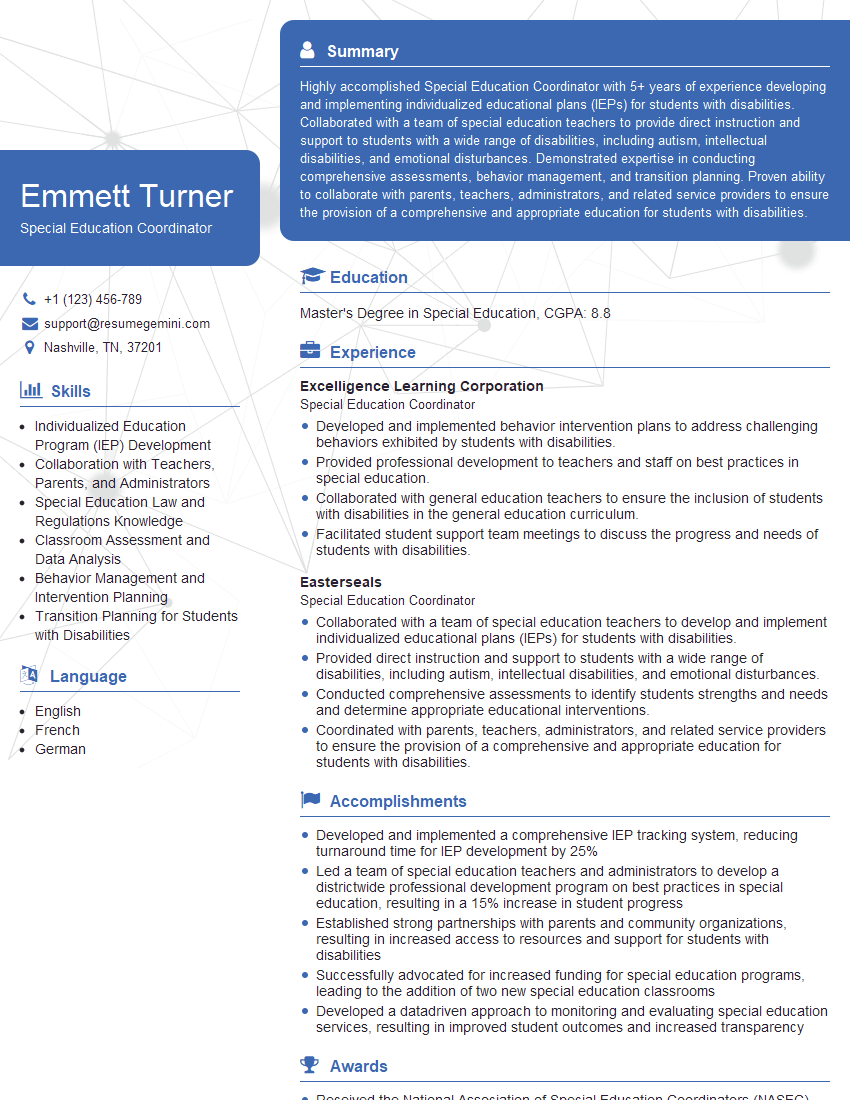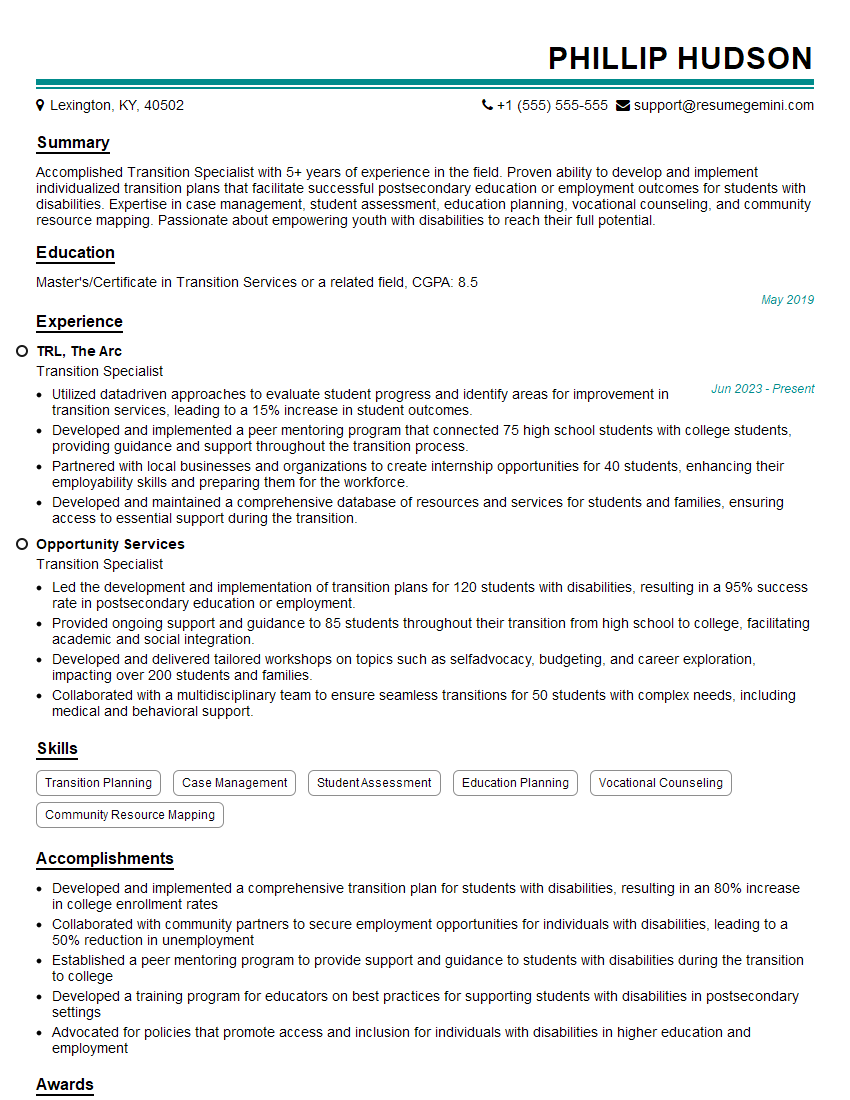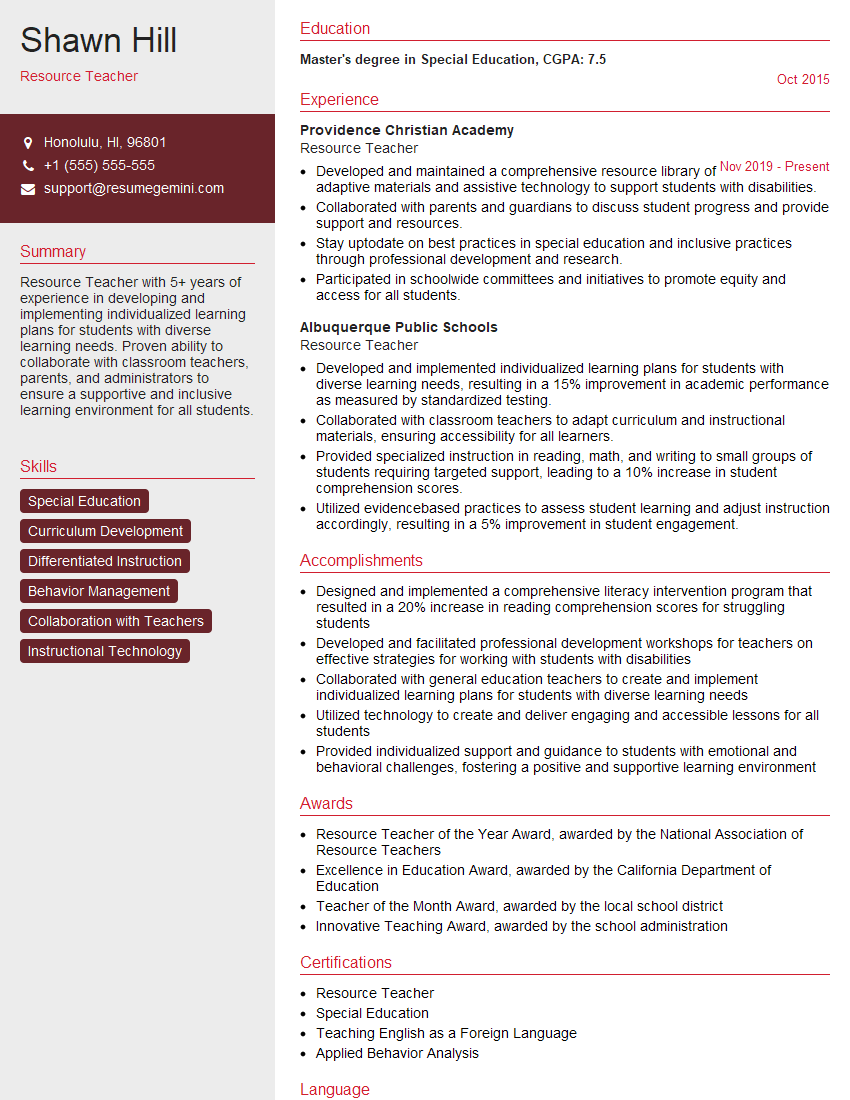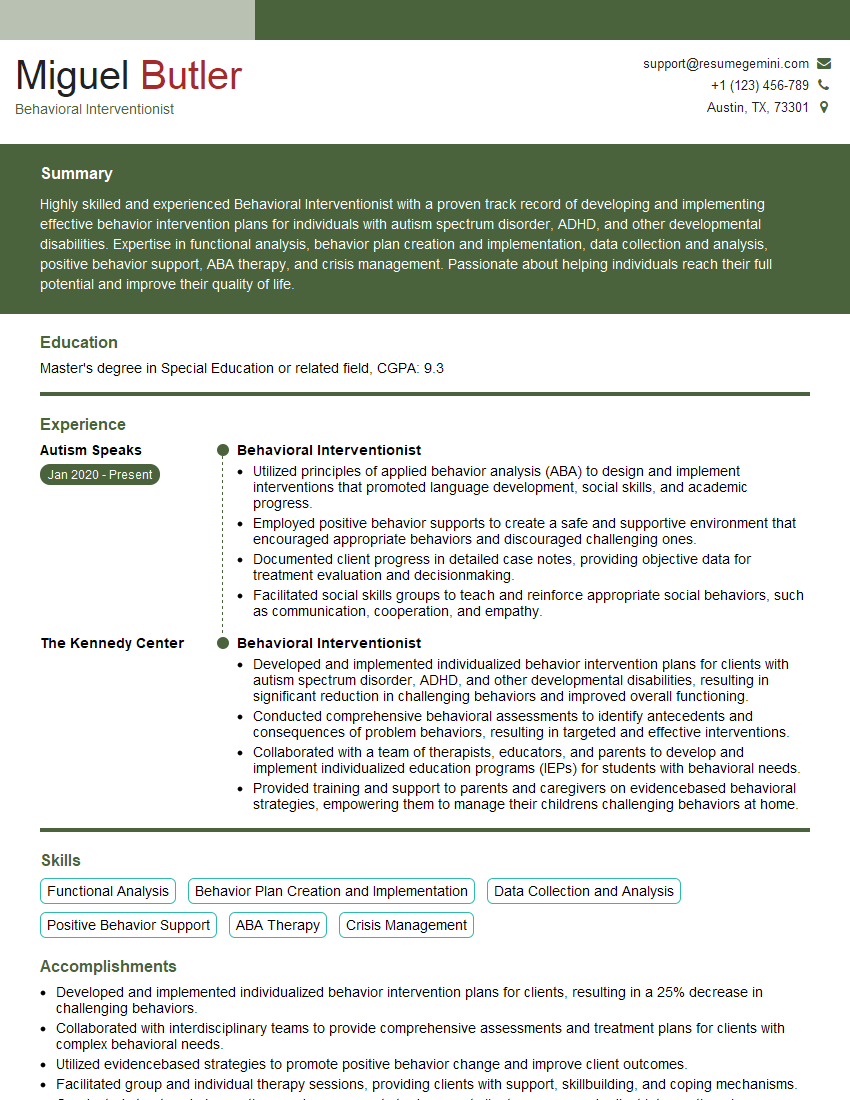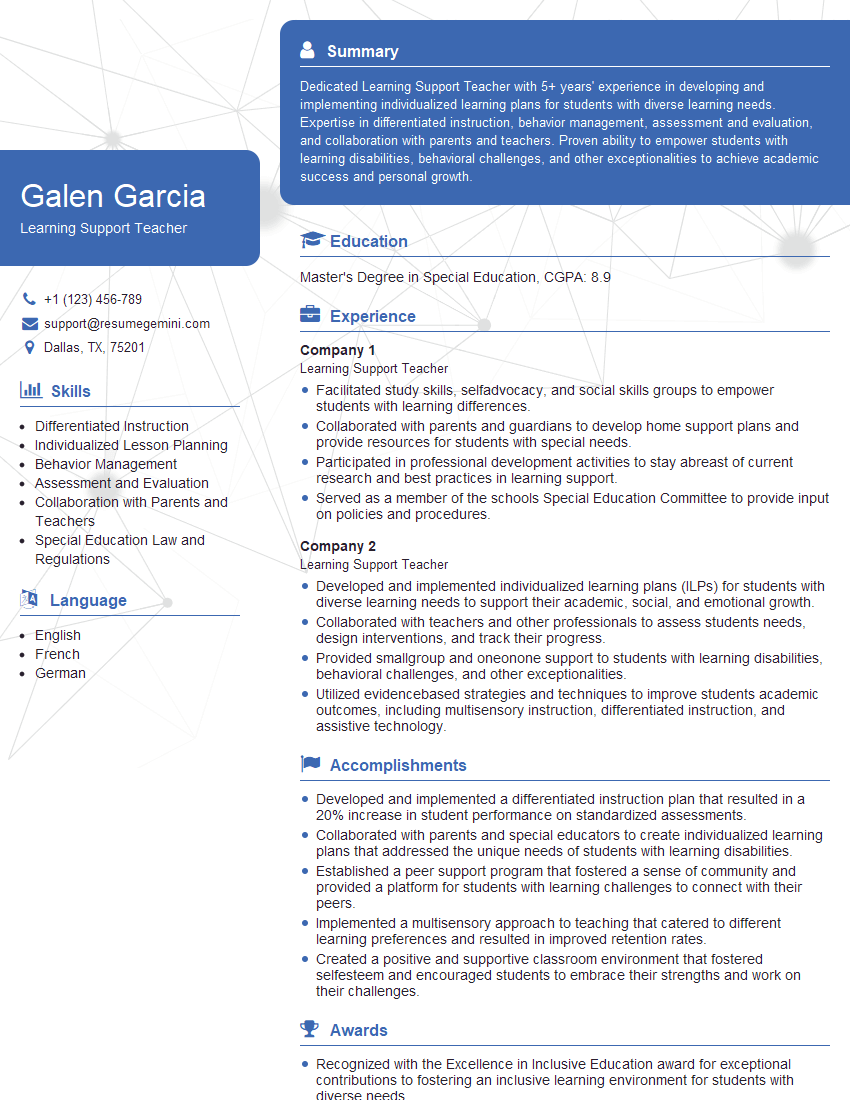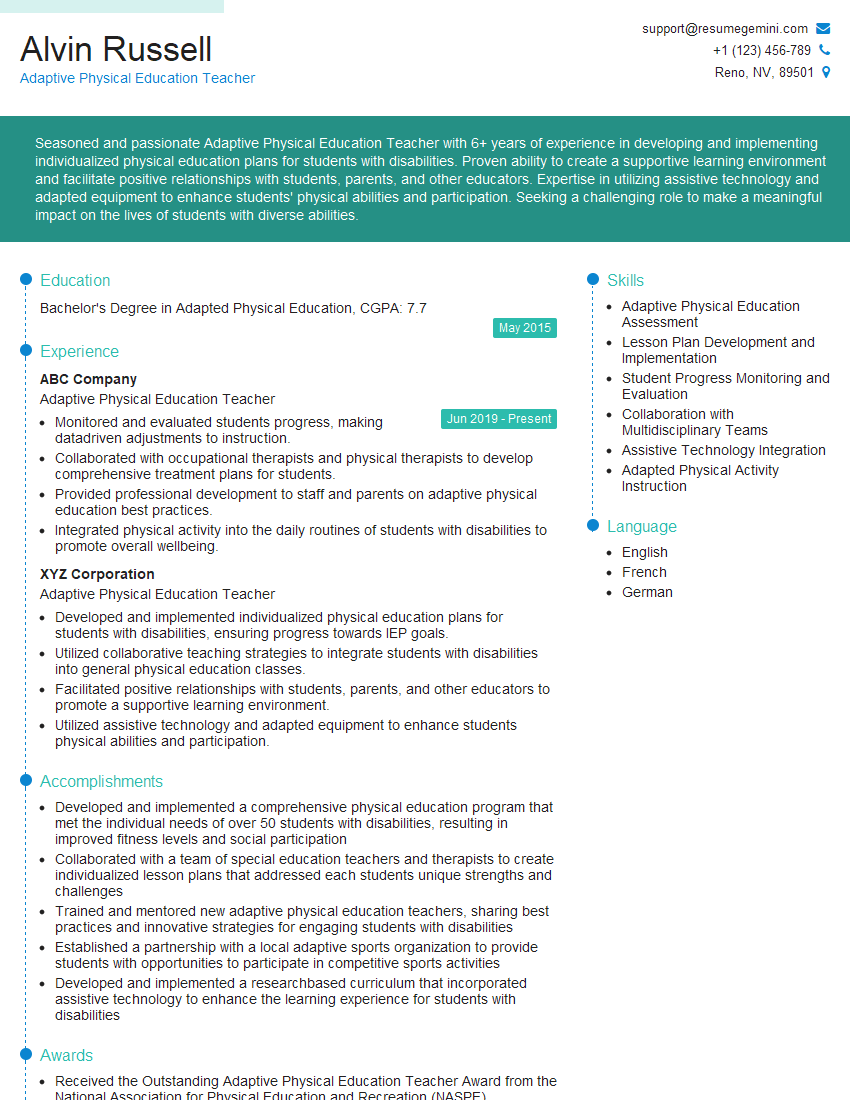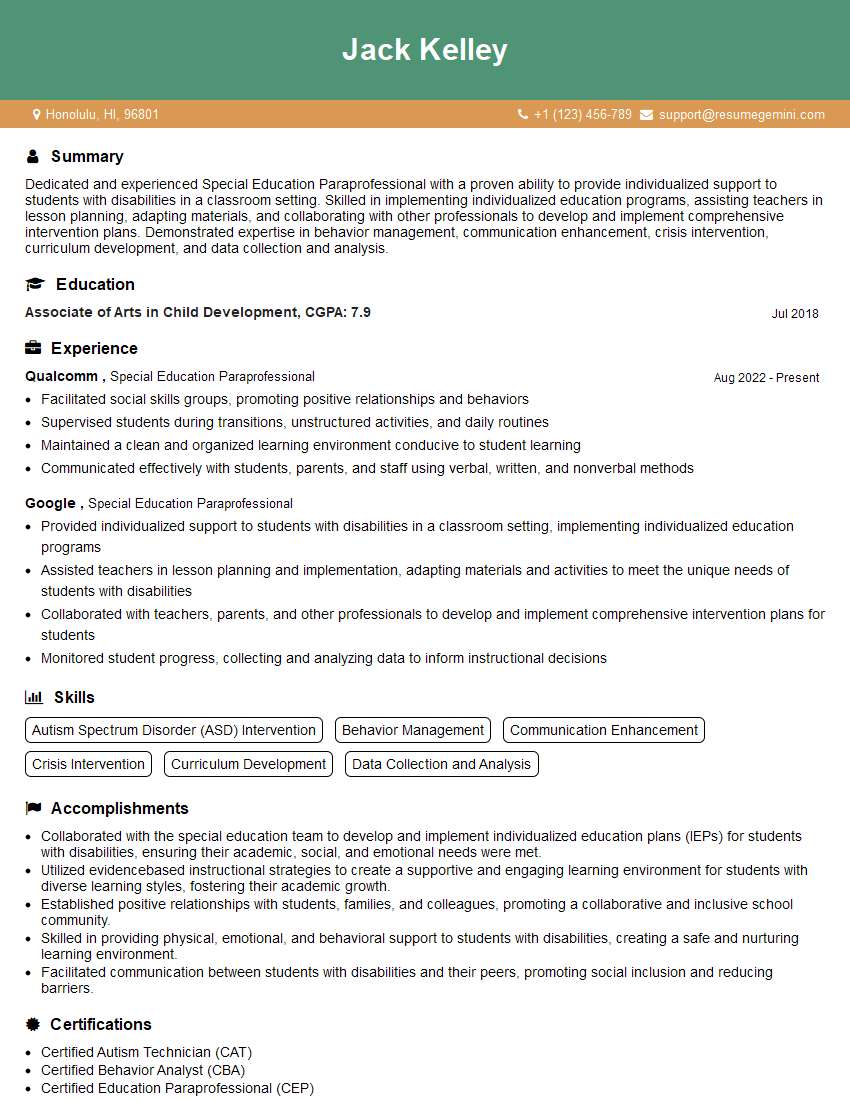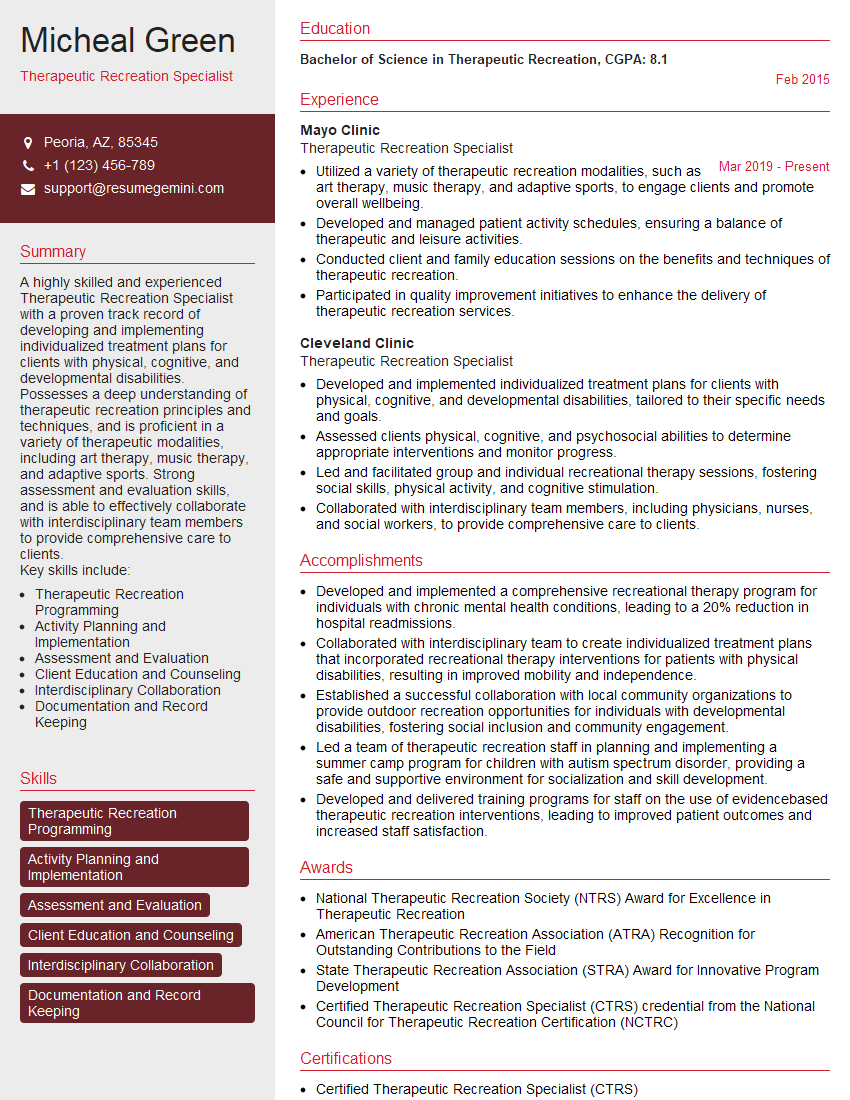The right preparation can turn an interview into an opportunity to showcase your expertise. This guide to Classroom Environment Management for Students with Mental Handicaps interview questions is your ultimate resource, providing key insights and tips to help you ace your responses and stand out as a top candidate.
Questions Asked in Classroom Environment Management for Students with Mental Handicaps Interview
Q 1. Describe your experience managing disruptive behaviors in a classroom of students with mental handicaps.
Managing disruptive behaviors in a classroom with students who have mental handicaps requires a nuanced approach that goes beyond simple punishment. It’s crucial to understand the root cause of the behavior. Is it a communication difficulty? Frustration with a task? Sensory overload? Once the underlying issue is identified, we can implement effective strategies.
- Functional Behavior Assessment (FBA): This is a cornerstone of my approach. An FBA involves systematically observing and documenting the behavior, identifying the triggers, and analyzing the function (what the student is getting out of the behavior). For example, a student might be screaming (disruptive behavior) because they are overwhelmed by loud noises in the classroom (trigger) and want to escape the situation (function).
- Positive Behavior Support (PBS): Instead of focusing solely on punishing the negative behavior, PBS emphasizes teaching and reinforcing positive behaviors. We proactively teach replacement behaviors – skills to help students cope with challenging situations. For a student who screams to escape, we might teach them to signal needing a break using a visual cue or a quiet space.
- Environmental Modifications: Sometimes, the classroom itself can contribute to disruptive behaviors. Adjusting the lighting, reducing noise levels, or creating designated quiet areas can make a significant difference. For a student sensitive to bright lights, dimming the classroom or providing a shaded area can significantly reduce anxiety and subsequent disruptive behaviors.
- Collaboration with Specialists: I always work closely with special education teachers, occupational therapists, and psychologists to create a holistic support plan. Their expertise is invaluable in understanding individual student needs and developing tailored interventions.
For instance, I once had a student who would frequently throw objects when frustrated. Through an FBA, we discovered it was a communication issue. He didn’t have the words to express his needs. We introduced a picture exchange system (PECS) and taught him to communicate his needs more effectively, reducing the throwing significantly.
Q 2. Explain your approach to differentiating instruction to meet the diverse needs of students with varying learning abilities.
Differentiated instruction is essential in a classroom with diverse learners. It’s about adapting teaching methods, materials, and assessment to meet the unique needs of each student. This involves considering their learning styles, abilities, and interests.
- Individualized Education Programs (IEPs): I work closely with IEP teams to develop personalized learning plans that outline specific goals, accommodations, and modifications for each student.
- Varied Instructional Strategies: I use a variety of methods like hands-on activities, visual aids, technology, and collaborative projects to cater to different learning styles. Some students might learn best through kinesthetic activities while others respond better to visual cues.
- Tiered Assignments: I often create assignments at different levels of complexity to challenge students at their respective skill levels. This ensures that all students are appropriately challenged but not overwhelmed.
- Assistive Technology: Utilizing tools like text-to-speech software, graphic organizers, and adaptive keyboards helps students overcome specific learning barriers and promotes accessibility.
For example, if I’m teaching about fractions, I might use manipulatives like fraction circles for students who need hands-on learning, while providing visual diagrams for visual learners, and offering simplified word problems for students who struggle with reading comprehension. The goal is to provide multiple pathways to mastering the concept.
Q 3. How do you create a positive and inclusive classroom environment for students with mental handicaps?
Creating a positive and inclusive classroom environment is paramount. It involves fostering a sense of belonging, respect, and mutual understanding among all students. This goes beyond simply avoiding negative interactions and actively cultivates a positive and supportive atmosphere.
- Establish Clear Expectations and Routines: Predictability and structure provide security and reduce anxiety for students with mental handicaps. A clearly defined classroom routine helps students anticipate what to expect, reducing uncertainty and potential triggers for disruptive behavior.
- Positive Reinforcement: Focusing on celebrating successes, both big and small, boosts student confidence and motivation. A token economy or reward system can be highly effective in encouraging positive behaviors.
- Promoting Peer Interaction: Pairing students with supportive classmates and creating opportunities for collaborative learning can foster friendships and enhance social skills.
- Creating a Physically Safe and Sensory-Friendly Environment: Minimizing distractions and sensory overload is vital. This may involve using calming colors, reducing clutter, providing quiet spaces, or utilizing noise-canceling headphones for students who are easily overwhelmed.
I often use visual schedules and social stories to help students understand classroom routines and expectations. These tools provide a sense of security and predictability, significantly reducing anxiety and promoting positive behavior.
Q 4. What strategies do you use to build rapport and trust with students with mental handicaps?
Building rapport and trust is fundamental to effective teaching. It’s about establishing a strong, positive relationship with each student based on mutual respect and understanding. This requires patience, empathy, and a genuine interest in each student’s well-being.
- Get to Know Each Student Individually: Spend time observing students, talking to them, and learning about their interests and challenges. Showing genuine interest in their lives builds connection.
- Use Positive Language and Encouragement: Focus on strengths and celebrate successes, offering positive feedback and encouragement. Avoid using negative or critical language.
- Non-Verbal Communication: Maintain appropriate eye contact, use calming body language, and ensure physical proximity is comfortable for each student.
- Consistency and Predictability: Following through on promises and maintaining a consistent approach builds trust and security.
For instance, I regularly spend time chatting with students about their hobbies or favorite activities. This simple act of showing interest fosters a connection and helps me understand them better. I also ensure that my tone and body language are always calm and reassuring.
Q 5. How do you adapt your teaching methods to accommodate students with different learning styles and sensory sensitivities?
Adapting teaching methods to accommodate different learning styles and sensory sensitivities requires a flexible and individualized approach. This might involve incorporating a variety of teaching methods and using assistive technology.
- Multi-Sensory Learning: Employing different sensory modalities enhances understanding. For visual learners, use diagrams, charts, and videos. For auditory learners, use audio books, discussions, and lectures. For kinesthetic learners, incorporate hands-on activities and movement.
- Sensory Adjustments: Provide a quiet space for students who are easily overwhelmed by noise, dim the lights for students sensitive to bright lights, or provide fidget toys for students who need to move.
- Flexible Seating Options: Offer a variety of seating arrangements, such as beanbag chairs, stability balls, or standing desks, allowing students to choose what works best for them.
- Assistive Technology: Utilize tools like text-to-speech software, visual supports, and adaptive learning platforms to aid students in accessing and processing information.
For example, I once had a student who had difficulty focusing in a traditional classroom setting. By providing him with a wobble cushion and allowing him to move around the classroom during independent work, his focus improved significantly, leading to improved academic performance.
Q 6. Describe your experience using assistive technology to support students with mental handicaps.
Assistive technology plays a crucial role in supporting students with mental handicaps. It can help students overcome learning barriers, access information, and participate more fully in classroom activities.
- Communication Devices: Augmentative and alternative communication (AAC) devices, such as picture exchange systems (PECS), speech-generating devices (SGD), or communication apps, are invaluable for students with communication difficulties.
- Adaptive Software: Text-to-speech software, screen readers, and word prediction tools facilitate access to digital learning materials.
- Adaptive Hardware: Adaptive keyboards, ergonomic mice, and specialized input devices improve students’ ability to interact with computers and other technology.
- Assistive Listening Devices: FM systems or personal amplification devices help students with hearing impairments hear instructions and classroom discussions clearly.
For instance, I’ve used GoTalk devices effectively with students who have difficulty expressing themselves verbally. The GoTalk allows them to use pictures to communicate their wants and needs. This has significantly improved their social interactions and overall participation in the classroom.
Q 7. How do you collaborate with parents and other professionals to support students with mental handicaps?
Collaboration is essential for supporting students with mental handicaps. It requires regular communication and shared decision-making among parents, teachers, other professionals, and the student (when appropriate).
- Parent-Teacher Conferences: Regular meetings with parents provide opportunities to discuss student progress, share observations, and collaboratively address challenges.
- Team Meetings: IEP meetings with specialists, such as special education teachers, therapists, and administrators, are key in developing and implementing effective support plans.
- Regular Communication: Maintaining open communication through email, phone calls, or online platforms keeps parents informed about their child’s progress and ensures a cohesive approach.
- Shared Decision-Making: Involving parents and other professionals in the decision-making process empowers everyone and ensures that the support plan is tailored to the student’s unique needs.
For example, I frequently communicate with parents through email or phone calls, sharing updates on their child’s progress and seeking their input on strategies. This open communication ensures that we’re all working together towards the same goal—supporting the student’s success.
Q 8. How do you incorporate positive behavior support strategies into your classroom management plan?
Positive Behavior Support (PBS) is a proactive approach to classroom management that focuses on teaching and reinforcing positive behaviors rather than solely punishing negative ones. It’s based on the understanding that challenging behaviors are often communication attempts, and addressing the underlying need is key. In my classroom, I incorporate PBS through several strategies:
- Functional Behavior Assessment (FBA): Before implementing any intervention, I conduct an FBA to understand *why* a student exhibits a specific behavior. This involves observing the student, interviewing relevant parties, and analyzing patterns. For example, if a student is throwing objects, the FBA might reveal they’re seeking attention or escaping a demanding task.
- Positive Reinforcement: I use a variety of positive reinforcement techniques, such as praise, rewards, and privileges, to encourage desired behaviors. A simple ‘great job focusing!’ can go a long way. I also utilize token economy systems where students earn tokens for positive behaviors that can be exchanged for desired items or activities.
- Teaching Replacement Behaviors: Instead of simply punishing a negative behavior, I teach the student a more appropriate way to meet their needs. For example, if a student is hitting to get attention, I teach them to raise their hand or use words to express their needs.
- Environmental Modifications: I adapt the classroom environment to minimize triggers for challenging behaviors. This might involve rearranging seating, providing a quiet corner, or adjusting the lighting. A student easily overwhelmed by visual stimuli might benefit from a less cluttered workspace.
By focusing on proactive strategies and teaching replacement behaviors, PBS helps create a more positive and supportive learning environment for all students.
Q 9. Explain your understanding of Individualized Education Programs (IEPs) and how you utilize them.
Individualized Education Programs (IEPs) are legally mandated documents that outline the specific educational needs and goals for students with disabilities. They are crucial for ensuring that each student receives the support and services they require to succeed. My role involves actively participating in IEP meetings, collaborating with the IEP team (parents, teachers, specialists), and utilizing the IEP to guide my instruction.
I use the IEP in several ways:
- Goal Setting: IEP goals provide specific, measurable, achievable, relevant, and time-bound (SMART) targets for each student. For instance, an IEP might aim for a student to improve their communication skills by a certain percentage over a semester.
- Instructional Planning: The IEP informs my lesson planning, ensuring that I adapt my teaching methods and materials to meet the student’s individual needs and learning styles. This could involve using visual aids, providing more time for tasks, or breaking down assignments into smaller steps.
- Progress Monitoring: The IEP guides my progress monitoring efforts, helping me track the student’s progress towards their goals. I use data from assessments, observations, and other measures to determine whether adjustments to the IEP or my teaching are needed.
- Collaboration: The IEP facilitates communication and collaboration with other professionals, such as special education teachers, therapists, and parents, ensuring a coordinated approach to supporting the student.
In essence, the IEP is the blueprint for providing a tailored education that maximizes the potential of every student with mental handicaps.
Q 10. Describe your experience with crisis intervention strategies and de-escalation techniques.
Crisis intervention and de-escalation techniques are vital skills for working with students who experience emotional or behavioral challenges. My approach focuses on preventing crises, and when they do occur, managing them calmly and safely.
Prevention involves creating a predictable and supportive classroom environment, teaching coping mechanisms, and building positive relationships with students. Proactive measures like consistent routines, clear expectations, and ample opportunities for communication are key.
De-escalation techniques I use include:
- Maintaining Calmness: My own composure is crucial; I model calm behavior even in stressful situations.
- Active Listening: I genuinely listen to what the student is saying, validating their feelings and concerns.
- Clear and Simple Communication: I use short, clear sentences and avoid jargon.
- Offering Choices: Giving a student a sense of control can help de-escalate tension. For example, “Do you want to sit here or at that table?”
- Physical Space: If appropriate, I provide the student with physical space and avoid confronting them directly.
- Redirection: If possible, I redirect the student’s attention to a calming activity.
In situations requiring more intervention, I utilize established protocols for contacting school support personnel and, when necessary, emergency services. Proper training and adherence to school policies are critical aspects of ensuring both student and staff safety.
Q 11. How do you monitor student progress and adjust your teaching accordingly?
Monitoring student progress and adjusting teaching is an ongoing process. It’s not a one-size-fits-all approach. I use a variety of methods:
- Regular Assessments: I regularly assess student understanding using both formal and informal methods. This includes quizzes, tests, observations, and anecdotal records.
- Data Analysis: I analyze assessment data to identify areas where students are struggling and areas where they excel. This allows me to pinpoint specific skills needing more attention.
- Differentiated Instruction: Based on the data, I differentiate my instruction to meet the individual needs of each student. This could involve modifying assignments, providing additional support, or using different teaching methods.
- Student Feedback: I actively solicit feedback from students to understand their learning experiences and identify areas for improvement. This might be through informal conversations or more structured feedback mechanisms.
- Collaboration: I work closely with colleagues, parents, and specialists to share information and develop strategies to support student learning.
For example, if a student is struggling with a particular math concept, I might provide one-on-one tutoring, use manipulatives, or break down the concept into smaller, more manageable parts. The key is ongoing evaluation and flexible adjustments.
Q 12. What are some common challenges you have encountered while working with students with mental handicaps?
Working with students with mental handicaps presents unique challenges. Some common ones include:
- Communication Difficulties: Many students may have difficulty expressing their needs and understanding instructions. This necessitates the use of alternative communication methods, such as visual aids or augmentative and alternative communication (AAC) devices.
- Behavioral Challenges: Students may exhibit challenging behaviors like aggression, self-injurious behavior, or withdrawal. Addressing these requires a multi-faceted approach, including functional behavior assessments and positive behavior support strategies.
- Sensory Sensitivities: Some students have heightened sensitivities to light, sound, or touch, which can impact their ability to focus and learn. Creating a sensory-friendly environment is critical.
- Cognitive Limitations: Students may have varying levels of cognitive abilities, requiring differentiated instruction and individualized learning plans. Lesson pacing and complexity need careful adjustment.
- Emotional Regulation: Students may struggle with emotional regulation, leading to outbursts or anxieties. Teaching coping skills and creating a supportive classroom climate are essential.
Addressing these challenges effectively requires patience, understanding, and a commitment to individualized support.
Q 13. How do you address challenging behaviors such as aggression or self-injurious behaviors?
Aggression and self-injurious behaviors are serious concerns that require careful and systematic intervention. My approach follows a multi-pronged strategy:
- Functional Behavior Assessment (FBA): As mentioned earlier, conducting a thorough FBA is crucial to understanding the function of the behavior. This helps identify triggers and develop effective interventions.
- Positive Behavior Support (PBS): Implementing PBS strategies, such as teaching replacement behaviors and modifying the environment, is key to reducing challenging behaviors.
- Antecedent Interventions: This involves identifying and modifying the environmental or situational factors that trigger the challenging behavior. For example, if a particular task causes frustration, breaking it into smaller steps or providing additional support can help.
- Consequence Interventions: While punishment is generally avoided, consequences may be necessary in certain situations. These should be consistent, predictable, and aligned with the school’s policies, focusing on redirection rather than retribution.
- Safety Procedures: Clear safety procedures must be in place for both the student and staff. This includes training in de-escalation techniques and emergency response protocols.
- Collaboration with Specialists: Working closely with school psychologists, therapists, and other professionals is essential for developing and implementing effective interventions.
It’s important to remember that addressing challenging behaviors is a collaborative effort that requires patience, consistency, and a focus on the student’s overall well-being.
Q 14. What are your strategies for promoting self-advocacy and independence in students with mental handicaps?
Promoting self-advocacy and independence is a crucial goal in educating students with mental handicaps. My strategies focus on empowering students to take control of their learning and lives:
- Teaching Self-Regulation Skills: I explicitly teach students strategies for managing their emotions, behavior, and attention. This might involve mindfulness techniques, relaxation exercises, or self-monitoring strategies.
- Choice-Making Opportunities: I provide students with meaningful choices throughout the day, helping them develop decision-making skills and a sense of control. For example, allowing choices in activities, work assignments or even preferred seating arrangements.
- Communication Skill Development: I focus on developing students’ communication skills, both verbal and nonverbal. This includes teaching assertive communication techniques and providing opportunities for practice.
- Goal Setting and Self-Monitoring: I work with students to set realistic goals and teach them how to monitor their progress toward those goals. This helps them develop self-awareness and self-efficacy.
- Collaboration with Parents and Support Staff: I work collaboratively with parents and other professionals to ensure that the strategies for promoting self-advocacy and independence are consistently applied across different settings.
- Real-World Application: I create opportunities for students to practice their self-advocacy skills in real-world contexts, such as participating in IEP meetings or communicating their needs to adults outside of the school setting.
Ultimately, fostering self-advocacy and independence builds confidence and empowers students to lead more fulfilling lives.
Q 15. Describe your experience with functional behavioral assessments (FBAs) and behavior intervention plans (BIPs).
Functional Behavioral Assessments (FBAs) are systematic processes used to understand the function or purpose of a student’s challenging behavior. They help us move beyond simply labeling the behavior and instead identify the triggers, antecedents, and consequences that maintain it. A Behavior Intervention Plan (BIP) is then developed based on the FBA findings. It’s a proactive strategy, not just a punishment plan, outlining specific interventions to teach replacement behaviors and reduce the challenging behaviors.
My experience involves conducting thorough FBAs, which include interviews with the student, parents, and teachers; observations of the student in various settings; and data collection on the frequency, intensity, and duration of the challenging behavior. For example, I worked with a student exhibiting frequent outbursts. The FBA revealed the outbursts occurred primarily when he felt overwhelmed by academic tasks. This led to a BIP involving providing him with shorter assignments, frequent breaks, and visual supports to manage his workload. The BIP was regularly monitored, and adjustments made as needed to ensure its effectiveness.
Developing a BIP is a collaborative process involving the student, parents, and school staff. It includes clearly defined target behaviors, interventions, data collection methods, and a plan for regular review and modification. It’s crucial to ensure the BIP is positive, focusing on teaching appropriate behaviors, rather than solely on punishing undesirable ones. We focus on teaching coping mechanisms and problem-solving strategies so the student can manage their emotions independently.
Career Expert Tips:
- Ace those interviews! Prepare effectively by reviewing the Top 50 Most Common Interview Questions on ResumeGemini.
- Navigate your job search with confidence! Explore a wide range of Career Tips on ResumeGemini. Learn about common challenges and recommendations to overcome them.
- Craft the perfect resume! Master the Art of Resume Writing with ResumeGemini’s guide. Showcase your unique qualifications and achievements effectively.
- Don’t miss out on holiday savings! Build your dream resume with ResumeGemini’s ATS optimized templates.
Q 16. How do you ensure the safety and well-being of all students in your classroom?
Ensuring student safety and well-being is paramount. My approach is multifaceted and proactive, beginning with creating a physically safe and inclusive environment. This includes regularly inspecting the classroom for hazards, ensuring appropriate supervision during transitions and activities, and implementing clear safety protocols. Beyond physical safety, I focus on emotional and social well-being.
I build positive relationships with each student based on trust and respect. This includes regularly checking in with students, actively listening to their concerns, and providing support when needed. Classroom rules and expectations are clearly communicated and consistently enforced, focusing on positive reinforcement rather than solely punishment. I collaborate closely with parents and support staff to maintain consistent expectations across different settings. In cases of serious behavioral concerns, I work collaboratively with the school’s crisis intervention team to implement appropriate strategies and ensure timely intervention. I use de-escalation techniques and crisis management strategies when necessary. Regularly reviewing safety plans and adapting them based on the evolving needs of the students is a critical ongoing process. It’s a holistic approach that considers every aspect of the student’s well-being.
Q 17. How do you incorporate social-emotional learning (SEL) into your curriculum?
Social-emotional learning (SEL) is woven into the fabric of my classroom. It’s not a separate subject; it’s integrated throughout the curriculum. I utilize various strategies to promote SEL, including:
- Morning Meetings: These provide a structured time for social interaction, sharing, and building community. We discuss feelings, practice empathy, and work on problem-solving skills collaboratively.
- Circle Time: Dedicated time for discussing social skills, emotions, and conflict resolution. We use role-playing and storytelling to address challenging situations.
- Mindfulness Activities: Incorporating breathing exercises and mindful moments into the day to promote self-regulation and stress management.
- Collaborative Projects: Group work encourages teamwork, communication, and empathy. Students learn to appreciate diverse perspectives and work towards common goals.
- Social Stories: These visual narratives help students understand social situations and expectations. They’re particularly effective for students who struggle with social cues.
By consistently practicing and reinforcing SEL concepts, I create a supportive and emotionally safe learning environment where students can thrive academically and socially.
Q 18. How do you adapt assessments to meet the needs of students with mental handicaps?
Adapting assessments is crucial to accurately measure the learning of students with mental handicaps. I use a variety of methods to ensure fair and meaningful assessment:
- Alternative Assessment Formats: Instead of traditional paper-and-pencil tests, I use oral exams, performance-based assessments, and portfolio assessments. These allow students to demonstrate their understanding in ways that are better suited to their strengths and learning styles.
- Modified Tasks: I adjust the complexity of tasks, reducing the number of items or providing additional support as needed. This ensures the assessment accurately reflects the student’s abilities without being unfairly difficult.
- Assistive Technology: I utilize assistive technology, such as text-to-speech software or speech-to-text software, to support students with reading or writing difficulties.
- Extended Time: Providing additional time for assessments allows students to complete the tasks without feeling rushed or overwhelmed.
- Breaking down complex tasks: I break tasks into smaller, more manageable steps, providing frequent feedback and support along the way. This approach ensures the student’s understanding of each component of the task before moving on.
Collaboration with special education teachers and therapists is essential to ensure assessments are appropriate, accurate, and aligned with individual student learning goals. The goal is not to lower expectations but to provide equitable opportunities for all students to demonstrate their learning.
Q 19. What are your strategies for fostering a sense of community and belonging in your classroom?
Fostering a sense of community and belonging is a top priority. I achieve this through several strategies:
- Classroom Jobs: Assigning classroom jobs gives students a sense of responsibility and ownership. It enhances their self-esteem and encourages cooperation.
- Positive Reinforcement: Regularly praising students’ efforts and achievements, both individually and as a class, builds confidence and encourages participation.
- Group Activities: Engaging students in group projects and games promotes teamwork, collaboration, and a sense of shared accomplishment.
- Celebrations: Celebrating individual and collective achievements makes students feel valued and creates a positive and supportive classroom culture.
- Building Relationships: Taking time to get to know each student individually, understanding their interests and needs, allows me to create a more inclusive environment.
I actively encourage students to support and respect one another, fostering a climate of empathy and mutual understanding. It’s about creating a space where each student feels seen, heard, and valued for who they are.
Q 20. How do you promote communication and collaboration among students with diverse communication styles?
Promoting communication and collaboration among students with diverse communication styles requires a flexible and adaptable approach. I use a variety of strategies to support communication:
- Augmentative and Alternative Communication (AAC): I utilize AAC devices and strategies, such as picture exchange systems (PECS) or communication boards, to support students who struggle with verbal communication.
- Visual Supports: Using visual schedules, social stories, and visual aids helps students understand expectations and routines.
- Sign Language: Incorporating basic sign language can help bridge communication gaps and create a more inclusive classroom environment.
- Peer Support: Pairing students with diverse communication styles can help them learn from each other and build communication skills.
- Modeling Effective Communication: I explicitly model clear and respectful communication to help students learn appropriate social interactions.
By providing multiple communication avenues and fostering a supportive environment, I ensure all students can actively participate in classroom activities and express their thoughts and ideas effectively. The goal is to create a classroom where communication is accessible and valued for all.
Q 21. What is your experience with different types of learning disabilities and their impact on classroom management?
My experience encompasses a wide range of learning disabilities, each presenting unique challenges for classroom management. For instance, students with Attention Deficit Hyperactivity Disorder (ADHD) may require frequent redirection, organizational support, and structured routines to maintain focus. Students with Autism Spectrum Disorder (ASD) may benefit from visual schedules, predictable routines, and clear communication strategies. Students with specific learning disabilities, such as dyslexia or dysgraphia, might need modifications in assessment and instruction, such as extended time, alternative assessment formats, and assistive technology.
Understanding the specific needs of each student is paramount. I collaborate closely with special education teachers, therapists, and parents to develop individualized education programs (IEPs) that address the student’s unique learning needs and challenges. Classroom management strategies are tailored to each student’s strengths and weaknesses, focusing on building their self-esteem, fostering independence, and creating a supportive learning environment where they can thrive. For example, a student with dyslexia might benefit from the use of audiobooks or assistive technology, while a student with ASD may benefit from a quiet workspace and visual supports. Each case requires an individualised approach in classroom management for optimal results.
Q 22. How do you handle conflicts between students with mental handicaps?
Handling conflicts between students with mental handicaps requires a nuanced approach that prioritizes understanding the root cause of the conflict and employing de-escalation techniques. It’s crucial to remember that behaviors often stem from unmet needs or communication difficulties.
My approach involves:
- Active Listening: I start by patiently listening to each student’s perspective, ensuring they feel heard and understood. I use simple language and visual aids if needed.
- Identifying Triggers: I work to identify the triggers that led to the conflict. This might involve reviewing classroom routines, observing interactions, and consulting with support staff.
- Conflict Resolution Strategies: Depending on the severity, I might use strategies like role-playing, mediation, or creating a collaborative solution. For example, if two students are fighting over a toy, we might establish a sharing schedule using visual timers.
- Positive Reinforcement: After the conflict is resolved, I focus on reinforcing positive behaviors and cooperation. This might involve rewarding collaborative problem-solving or simply acknowledging their efforts to resolve the issue.
- Individualized Support: I understand that each student is unique, and their needs vary. I might involve their individual education plan (IEP) goals in the conflict resolution process, tailoring my approach to their specific needs and abilities.
For example, I once had two students with autism spectrum disorder who were having difficulty sharing crayons. By creating a visual schedule showing each student when it was their turn, combined with positive reinforcement for following the schedule, I successfully de-escalated the situation and taught them a valuable social skill.
Q 23. Describe your experience with data-based decision making in special education.
Data-based decision making (DBDM) is essential in special education because it allows us to make informed choices about instruction and interventions, ultimately leading to better outcomes for our students. It’s a cycle of assessment, analysis, and action.
My experience with DBDM includes:
- Collecting Data: I regularly collect data on student performance through various assessments, such as observations, work samples, and standardized tests. I use a variety of assessment methods tailored to individual needs, considering alternative communication methods if necessary.
- Analyzing Data: Once data is collected, I analyze it to identify patterns and trends. This might involve graphing student progress, calculating averages, or comparing performance across different settings or interventions. For instance, I might track the frequency of a challenging behavior to see if an intervention is effective.
- Making Data-Driven Decisions: Based on my analysis, I adjust my instructional strategies and interventions. If a particular approach isn’t effective, I modify it or try a different one, always keeping in mind the specific needs of the student and using the data to inform my choices.
- Monitoring Progress: I continuously monitor student progress to ensure that the chosen interventions are working. If changes are needed, I make adjustments based on the updated data. This cyclical approach guarantees ongoing refinement and improvement.
For example, I used data on a student’s reading fluency to determine that a specific phonics intervention was not effective. Based on this data, I implemented a different approach focused on multi-sensory techniques, which significantly improved the student’s reading skills.
Q 24. What strategies do you use to effectively communicate with parents of students with mental handicaps?
Effective communication with parents of students with mental handicaps is crucial for a successful educational experience. Building trust and establishing a collaborative partnership are key.
My strategies include:
- Regular Communication: I maintain regular contact with parents through phone calls, emails, and parent-teacher conferences, keeping them informed about their child’s progress, challenges, and upcoming events.
- Clear and Concise Communication: I avoid jargon and use clear, simple language, explaining concepts in a way that is easy for parents to understand. I also use visual aids such as graphs and charts to illustrate student progress.
- Active Listening: I actively listen to parents’ concerns and perspectives, valuing their input and incorporating it into my planning.
- Collaborative Goal Setting: I work collaboratively with parents to set realistic and achievable goals for their child’s education. We discuss strategies and make plans together, fostering a sense of shared responsibility and commitment.
- Positive and Encouraging Language: I use positive and encouraging language, focusing on their child’s strengths and progress, even when discussing challenges. This helps maintain a positive and collaborative relationship.
For example, I regularly use progress reports with visual representations of a student’s achievements to communicate with parents, making it easier for them to understand and celebrate their child’s progress.
Q 25. How do you adapt your curriculum to ensure access for all learners, including those with mental handicaps?
Adapting the curriculum to ensure access for all learners, including those with mental handicaps, involves creating a flexible and individualized learning environment. This means moving away from a ‘one-size-fits-all’ approach and focusing on meeting the unique needs of each student.
My strategies include:
- Differentiated Instruction: I differentiate instruction by adjusting the content, process, product, and learning environment based on the students’ individual needs and learning styles. This may involve simplifying tasks, breaking down complex concepts, or providing alternative assessments.
- Universal Design for Learning (UDL): I incorporate UDL principles to create flexible learning experiences that cater to diverse learners. This focuses on providing multiple means of representation (how information is presented), action and expression (how students demonstrate their learning), and engagement (how learners are motivated and challenged).
- Assistive Technology: I utilize assistive technology, such as communication devices, adaptive software, or specialized learning tools to support students’ participation and learning.
- Individualized Education Programs (IEPs): I work closely with IEP teams to develop customized IEPs that outline specific goals, accommodations, and modifications for each student. These plans are regularly reviewed and adjusted to meet evolving needs.
- Collaboration with Support Staff: I collaborate with other professionals, such as occupational therapists, speech therapists, and special education specialists, to create a supportive learning environment.
For example, for a student with a visual impairment, I might use large-print materials, audiobooks, and tactile learning activities, while for a student with an auditory processing disorder, I might provide visual cues and written instructions alongside verbal ones.
Q 26. What is your approach to working with students who have anxiety or other mental health concerns?
Working with students who have anxiety or other mental health concerns requires a compassionate, supportive, and understanding approach. It’s crucial to create a safe and predictable classroom environment where students feel comfortable and accepted.
My approach involves:
- Creating a Safe and Predictable Environment: I establish clear routines and expectations to minimize uncertainty and reduce anxiety. I use visual schedules and timers to help students anticipate changes and transitions.
- Building Positive Relationships: I build strong, positive relationships with students, showing empathy and understanding. I use positive reinforcement and praise to build their self-esteem and confidence.
- Mindfulness and Relaxation Techniques: I teach students mindfulness and relaxation techniques such as deep breathing exercises or guided imagery to help manage anxiety and stress. These can be incorporated into the daily routine.
- Collaboration with Support Staff: I collaborate closely with school counselors, psychologists, and other support staff to develop an effective support plan for students with mental health concerns. This might include referrals for additional support.
- Accommodations and Modifications: I provide appropriate accommodations and modifications to the curriculum and classroom environment to meet the needs of students experiencing anxiety or other mental health challenges. This might include allowing extra time for assignments, reducing workload, or providing alternative assessment methods.
For example, I might work with a student struggling with test anxiety by providing a quiet testing environment, allowing breaks, and providing frequent positive feedback during the testing process.
Q 27. How do you ensure confidentiality and maintain appropriate professional boundaries with students and their families?
Maintaining confidentiality and appropriate professional boundaries with students and their families is paramount. It is crucial to adhere to ethical guidelines and legal regulations.
My approach involves:
- Confidentiality: I strictly adhere to confidentiality guidelines, only sharing information with authorized personnel such as parents (with student consent where appropriate), IEP team members, and other relevant professionals involved in the student’s care. Information is shared only on a need-to-know basis.
- Professional Boundaries: I maintain clear professional boundaries, avoiding any behavior that could be perceived as inappropriate or exploitative. This includes respecting students’ personal space, avoiding personal disclosures, and maintaining appropriate communication channels.
- Informed Consent: I obtain informed consent from parents or guardians before sharing any information about the student, or engaging in any activity outside of typical educational practices.
- Data Security: I securely store and manage all student records and data, adhering to school and district policies regarding data privacy and security.
- Ethical Decision-Making: I always make ethical decisions, prioritizing the well-being and best interests of my students.
For instance, if a student shares sensitive information, I carefully document it, but only share it with those who are directly involved in their care and support, ensuring all communication adheres to strict confidentiality protocols.
Q 28. What professional development activities have you undertaken to enhance your skills in working with students with mental handicaps?
Continuous professional development is essential in the field of special education to stay updated on best practices and refine my skills. I actively seek opportunities to enhance my knowledge and expertise in working with students with mental handicaps.
My professional development activities include:
- Workshops and Conferences: I regularly attend workshops and conferences focused on topics such as autism spectrum disorder, intellectual disabilities, behavioral interventions, and trauma-informed care.
- Continuing Education Courses: I complete continuing education courses to earn professional development credits and stay current on the latest research and best practices in special education.
- Mentorship and Collaboration: I actively participate in mentorship programs and collaborate with experienced professionals to share best practices and learn from each other.
- Reading Professional Literature: I regularly read professional journals and books to stay up-to-date on research findings and innovative teaching strategies.
- Online Courses and Webinars: I utilize online resources, such as webinars and online courses, to enhance my knowledge and skills in specific areas of interest.
For example, I recently completed a course on applied behavior analysis (ABA), which has significantly improved my ability to design and implement effective behavioral interventions for students with challenging behaviors.
Key Topics to Learn for Classroom Environment Management for Students with Mental Handicaps Interview
- Understanding Diverse Needs: Learning about the spectrum of mental handicaps and tailoring your approach to individual student requirements. This includes understanding different learning styles, communication preferences, and sensory sensitivities.
- Creating a Safe and Supportive Classroom: Designing a physical and emotional environment that fosters a sense of security, belonging, and reduces anxiety. Practical application includes considering classroom layout, sensory input management, and establishing clear routines and expectations.
- Behavior Management Strategies: Developing and implementing positive behavior support plans (PBSPs) that address challenging behaviors proactively and constructively. This includes understanding the function of behavior and employing evidence-based interventions.
- Collaboration and Communication: Effectively communicating with students, parents/guardians, and other professionals (e.g., therapists, special education teachers) to create a cohesive support system for the student.
- Adapting Curriculum and Instruction: Modifying teaching methods and materials to meet the unique learning needs of students with mental handicaps. This involves utilizing differentiated instruction, assistive technology, and adaptive assessments.
- Individualized Education Program (IEP) Implementation: Understanding the IEP process and effectively implementing goals and objectives within the classroom environment.
- Promoting Inclusion and Socialization: Creating opportunities for students with mental handicaps to interact positively with their peers and participate fully in classroom activities. This includes fostering peer support and addressing social skills deficits.
- Crisis Management and Intervention: Developing and practicing strategies to manage challenging behaviors and crisis situations effectively and safely.
- Data Collection and Analysis: Tracking student progress, analyzing data to inform instructional decisions, and demonstrating the effectiveness of interventions.
Next Steps
Mastering Classroom Environment Management for Students with Mental Handicaps is crucial for a fulfilling and impactful career in special education. It demonstrates your dedication to supporting vulnerable learners and achieving positive outcomes. To maximize your job prospects, create an ATS-friendly resume that highlights your relevant skills and experiences. ResumeGemini is a trusted resource that can help you build a professional and impactful resume. Examples of resumes tailored to Classroom Environment Management for Students with Mental Handicaps are available to further guide your preparation.
Explore more articles
Users Rating of Our Blogs
Share Your Experience
We value your feedback! Please rate our content and share your thoughts (optional).
What Readers Say About Our Blog
Hi, I’m Jay, we have a few potential clients that are interested in your services, thought you might be a good fit. I’d love to talk about the details, when do you have time to talk?
Best,
Jay
Founder | CEO

